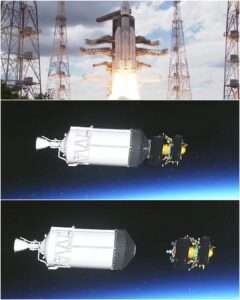Welcome to our comprehensive article on the Chandrayaan 3 launch, where we will delve into the exciting realm of space exploration. Here, we will provide you with up-to-date information and insights about the Chandrayaan 3 mission, its significance, and the advancements it promises to bring to the scientific community. So fasten your seatbelts and get ready for an exhilarating journey through the cosmos!

India’s third lunar mission, Chandrayaan-3, is scheduled and successfully launch at July 14, 2023, at 14:35 pm IST from the Satish Dhawan Space Centre in Sriharikota. The mission will be carried by the Launch Vehicle Mark-III (LVM3), India’s most powerful rocket.
Chandrayaan 3 Launch: A Glimpse into the Future
The Chandrayaan 3 mission has captured the imagination of people around the world, and rightfully so. With its ambitious goals and cutting-edge technology, this mission promises to open new frontiers in lunar exploration and scientific research. In this section, we will explore the key highlights and objectives of the Chandrayaan 3 mission.
Objectives of the Chandrayaan 3 Mission
The primary objective of the Chandrayaan 3 mission is to successfully land a rover on the lunar surface and conduct extensive scientific experiments. This mission aims to build upon the successes of its predecessors, Chandrayaan 1 and Chandrayaan 2, and further expand our understanding of the Moon’s geology, mineralogy, and lunar exosphere.

Challenges and Innovations in the Chandrayaan 3 Mission
The Chandrayaan 3 mission poses several technical challenges that the Indian Space Research Organization (ISRO) has worked tirelessly to overcome. One of the main challenges is the successful soft landing of the rover on the Moon’s surface. To accomplish this, ISRO has incorporated innovative landing technologies and refined the guidance and control systems of the spacecraft.
Instruments and Experiments on board Chandrayaan 3
Chandrayaan 3 is equipped with a suite of state-of-the-art instruments and experiments to gather valuable data about the lunar surface. Some of the key instruments include:
- Alpha Particle X-ray Spectrometer (APXS): This instrument will analyze the elemental composition of lunar rocks and soil, providing insights into the Moon’s geology and evolution.
- Laser-Induced Breakdown Spectroscopy (LIBS): LIBS will help identify various elements present on the lunar surface by analyzing the light emitted when laser pulses interact with the surface.
- Imaging Infrared Spectrometer (IIRS): IIRS will capture high-resolution images of the Moon’s surface in the infrared spectrum, enabling scientists to study the distribution of minerals and water molecules.

Timeline of the Chandrayaan 3 Mission
While the exact launch date of Chandrayaan 3 is yet to be announced, the mission is expected to take place within the next couple of years. The timeline will involve several crucial stages, including the launch, lunar transfer, lunar orbit insertion, and the eventual landing of the rover on the Moon’s surface.


What is the purpose of the Chandrayaan 3 mission?
The Chandrayaan 3 mission aims to land a rover on the lunar surface and conduct scientific experiments to enhance our understanding of the Moon’s geology and mineralogy.
How is Chandrayaan 3 different from Chandrayaan 2?
Chandrayaan 3 is a follow-up mission to Chandrayaan 2, with a specific focus on achieving a successful soft landing on the lunar surface. It incorporates lessons learned from the previous mission to improve the chances of a successful landing.
What are the key instruments on board Chandrayaan 3?
Chandrayaan 3 carries instruments such as the Alpha Particle X-ray Spectrometer (APXS), Laser-Induced Breakdown Spectroscopy (LIBS), and Imaging Infrared Spectrometer (IIRS) to analyze the lunar surface and gather valuable data.
When is the expected launch date of Chandrayaan 3?
While the launch date has not been officially announced, Chandrayaan 3 is expected to be launched within the next few years.
What are the technical challenges involved in the Chandrayaan 3 mission?
The main technical challenge is the successful soft landing of the rover on the Moon’s surface. ISRO has incorporated innovative landing technologies and refined guidance and control systems to address this challenge.
What are the potential discoveries we can expect from Chandrayaan 3?
Chandrayaan 3 has the potential to uncover new information about the Moon’s geology, mineralogy, and the presence of water molecules. These discoveries can significantly contribute to our understanding of the lunar environment and its evolution.
The Chandrayaan 3 mission represents an important milestone in India’s space exploration endeavors. With its ambitious goals and advanced technology, this mission has the potential to unlock new discoveries and deepen our understanding of the Moon. As we eagerly await the launch of Chandrayaan 3, the scientific community and space enthusiasts alike anticipate the groundbreaking insights it will provide. Let us join hands and celebrate humanity’s quest for knowledge and exploration.
